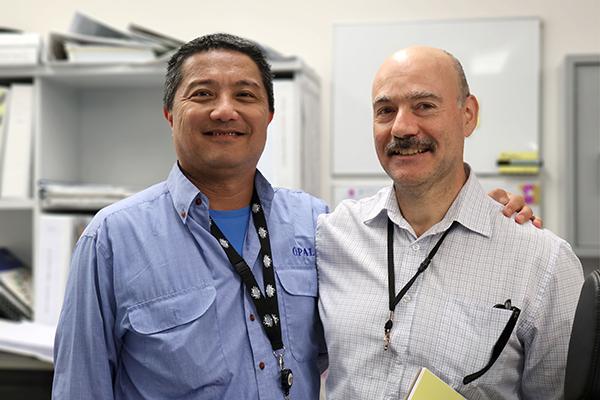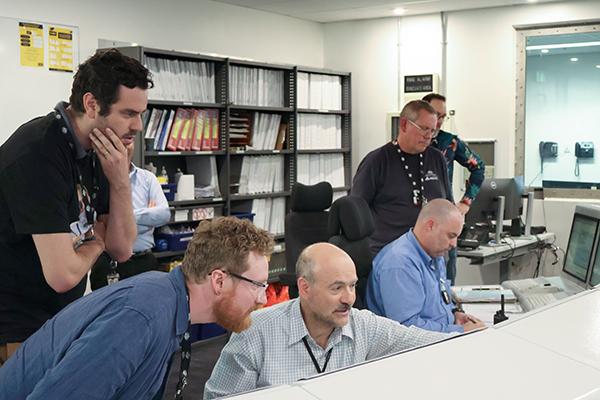In Part 2 of our three part series, we highlight the contribution of the nuclear analysis team to the CNS project and OPAL restart.
A team of nuclear analysts, who monitor and contribute to the operation of the OPAL multi-purpose reactor occupy one of the older buildings at Lucas Heights only a short distance from it.
This is a world of powerful and esoteric mathematical tools, including Monte Carlo, computational fluid dynamics, computational structural mechanics and other modelling methods.
Their calculations predict and guide reactor operations, verify designs, and models to estimate the signals that instruments will detect, which is essential for ensuring safe and successful startups.
The group is lead by Dr George Braoudakis, who was in the control room when the OPAL reactor first went critical in 2006. His team recently had a significant role in the re-design and optimisation of a cold neutron source (CNS) facility for the reactor, its installation and the subsequent restart after a six-month shutdown.

The Cold Neutron Source
One member of the nuclear analysis group, Dr Weijian Lu is ANSTO’s specialist in the design and operations of the CNS. He undertook the neutronic and thermohydraulic calculations to verify the original CNS design in early 2000s, in terms of the cold neutron flux to be delivered to the neutron instruments, as well as verifying the stability of the -250 °C liquid deuterium thermosiphon based on natural circulation.
“The OPAL CNS is an optimised passive system. Under cryogenic helium cooling, the deuterium moderator liquifies and stays liquid, which is a superior design feature than most other CNS facilities in the world.” explained Dr Lu.
He was a member of the CNS optimisation task force more than ten years ago and played a key role in improving the original CNS to achieve greater reliability.
When the project to replace the CNS was initiated in 2015, there was a focus to improve both the reliability and scientific capability of the new CNS.
“To provide a reliable and improved replacement, we know we had to improve the CNS without adding undue operational risks. The Nuclear Analysis Section performed scientific design calculations for the Project, which was responsible for the mechanical design, build and installation of it. And the OPAL team has been the operator and possessed the engineering expertise,” explained Dr Lu.
“I was part of both teams and acted as a bridge to determine the feasibility and ramifications of any design improvements. “
The new CNS was projected to bring a marginal increase in cold neutron flux, but an extra amount of heat load was predicted, which would challenge the refrigeration power of the helium cryogenic system.
“By the time the new CNS was successfully installed and tested by the Manoeuvre Team, everyone was already celebrating. For me, it wasn’t until the theoretical predictions were proven, that I finally felt we had achieved our goal and delivered a CNS that is among the best in the world.”
Reactor restart with new CNS

Dr Braoudakis led the support that was provided by the Nuclear Analysis Group.
He was close to the challenges associated with the reactor restart once the CNS was in the reactor pool and working.
“When we normally start up, we use the installed instrumentation for a normal scenario, but because of the extended shut down period, we anticipated that the signal would be out of range of our normal instrumentation.
“You can’t start up if you can’t see what it is going on through your instruments.
“We needed to do some modelling and calculations to try and estimate what those instruments would see, and that was challenging because we’ve never done that before,” he added.
The inherent design of the reactor determines the startup process.
“Spent fuel in the reactor has decaying fission products, which give off gamma rays. Those gamma rays interact with the deuterium in the heavy water that surrounds the core and produce photo neutrons. That’s the signal that we’re detecting. It is the source of neutrons that we use to start up.
Calculations of the neutron yield from this photoneutron production are crucial during startup.
“Because those gammas are from decaying fission products, the longer you’re shut down, the less you’re going to get. Because they’re decaying, eventually we’ll get to a level that’s below what those detectors can read.”
New calculations determined what those fission products would be after six months.
“We were in new territory with the analysis. On top of that, we then had to try and work out what the corresponding power was.”
The process included rebuilding and recommissioning the startup channels, which hadn’t been used since 2008.
“The instrumentation engineers did a great job. They worked perfectly. The utilisation team, also put them in exactly the right position, which was important,” said Dr Braoudakis.
Next steps were to work out what the corresponding startup power because our safety case says that long as the startup power is above 100 watts, the reactor is operating within expected parameters.
“We’ve got an analysis that proves it’s OK above this threshold. As it turned out, our calculated startup power was much lower than 100 watts, so we had to update the safety case, and do a new set of analysis. And then present this information to the independent nuclear regulator, ARPANSA. It also meant that all of our trip set points for our instrumentation all had to change too.”
Operators use trip set points when starting a reactor. Everything must match the calculations provided by the nuclear analysis group, as reactor power is slowly increased.
“At a certain point, the process was stopped while all of the trip set points were changed tonormal operating power.
“It was anything but straightforward,” said Dr Braoudakis. “Our analysis predicted that the startup power would be something like 3 1/2 watts. In the end it was about 5 ½ watts, which is close.”
The nuclear analysts also provided estimates of the response of the photoneutron source including subcritical multiplication of the shutdown core with an absolute calibration of the wide range log channels and a detailed photoneutron source distribution.
These log channels provide indications in the control room of neutron power and the rate of change of neutron power.
As the most experienced nuclear analysts at ANSTO, George was in the control room with the OPAL operations team while the startup progressed.
“I was there to train members of the team and explain things. Part of it is making sure everyone is happy with everything that is happening. We set the limits and then we checked and made sure that everything was progressing the way we expected within tolerance ranges. And it was,” he said with the cheeky smile he is known for when things go well.
In Part 3 of our series, we will feature the project from the perspective of one engineer.







